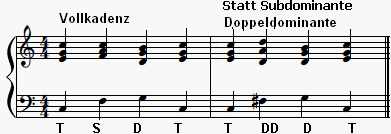Double dominant
The double dominant is a chord which , in functional theory, is a special case of an intermediate dominant to the dominant . The double dominant is the dominant of the dominants. It must therefore be formed from the fifth degree of the fundamental from the triad on the fifth degree.
Examples:
Example: First normal full cadence T SDT , then the cadence T DD DT with the double dominant instead of the subdominant.

|
- Tonic: C minor ; Dominant: G major; Double dominant: D major
Example: First the normal full cadence ts D t , then the cadence t DD D t with the double dominant instead of the subdominant.

|
Since a dominant (and thus also the intermediate and double dominant) is usually a major triad, the double dominant uses a tone not inherent in the ladder : The double dominant in the key of C major is D major and requires an F sharp , which is in C- Major scale is not included. In the minor key, the use of a double dominant is even more noticeable, here the 2nd degree is usually a diminished chord , so two notes have to be altered to get a major chord. For the example mentioned, this means: the notes of the second degree in C minor are df-a -flat ; the double dominant is formed need f in fis and as in a can be changed.
In baroque music , the double dominant is used sparingly at first, but in conspicuous places, from the Viennese classical period it is a chord that is a permanent part of the cadenza. The chords are also used with characteristic dissonances (e.g. in ragtimes or jazz ) . Thus, for the dominant like the seventh and the double dominant the seventh and the None used. A typical cadence in C major would e.g. B .:
- D 7/9 → G 7 → C
determination
The double dominant is found 2 notes to the right of the tonic on the circle of fifths.
See also
Individual evidence
- ↑ Lars Ulrich Abraham: Harmony. Volume 1: The homophonic sentence (= music pocket books - Theoretica . TB 250). 3. Edition. Laaber-Verlag, Laaber 1984, ISBN 3-89007-001-9 , p. 192.